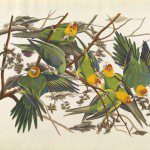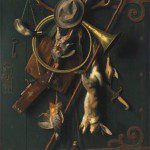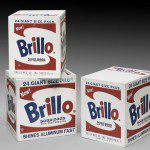Still Life in Philly
By • November 5, 2015 0 1514

Portraitist of Washington, Franklin, Jefferson, Hamilton and other figures of the American Revolution, Charles Willson Peale raised a family of painters in Philadelphia, naming his sons Rembrandt, Raphaelle, Titian and Rubens and his daughters Angelica and Sophonisba (not a complete list).
One of the major works in the Philadelphia Museum of Art’s new exhibition, “Audubon to Warhol: The Art of American Still Life” (on view through Jan. 10) is Peale’s group portrait of his family: nine peaches-and-cream-faced Peales, including himself; the children’s nanny; and his dog Argus. On the green tablecloth is a still life — a tray of fruit next to a paring knife and a curled apple peel (pun no doubt intended).
On each side of this canvas, nearly seven and a half feet wide, are two small still-life paintings by Peale family members; nearby are classic still lifes by Raphaelle, one of the first American artists to specialize in the genre. His father, like many artists before and since, considered flowers, fruit, cheese, cutlery, serving ware, wine bottles, dead fish and the like more a subject for artistic training than for finished works, despite the still-life obsessions of Dutch Golden Age painters (excluding Rembrandt and Hals).
Grouping outstanding examples, many unfamiliar, in roughly chronological order under the thematic headings of Describing, Indulging, Discerning and Animating, the exhibition — the first of its kind in three decades — aims to make the case that, in the words of curator Mark D. Mitchell, “the story of American still life is the story of American life.”
At several points, context is provided in inventive ways. Plate 26 from John James Audubon’s “Birds of America,” depicting now-extinct Carolina parakeets, is accompanied not only by several of the huge folio volumes but by four specimens collected in 1843 and owned by Audubon, their colors — orange, yellow and turquoise — still bright.
In the Indulging section, visitors can explore the language of flowers at “You In Flowers” interactive stations, which generate personalized (sort of) on-screen bouquets from self-submitted adjectives.
Velvet curtains evoke the Gilded Age setting of William Harnett’s largest trompe-l’oeil (trick the eye) painting, “After the Hunt” of 1885, painted for the Paris Salon but purchased for Theodore Stewart’s extravagant New York saloon. Trained in Munich, Harnett was a genius at depicting feathers (dead game birds), fur (a dead rabbit), metal (two firearms and a hunting horn) and the life-size green door — with rusty ornamental hinges, a keyhole escutcheon and a dangling key — on which these and other precisely rendered objects appear to hang.
The superb selection of trompe-l’oeil works in the Discerning section includes “Reminiscences of 1865,” the movingly subliminal tribute to Lincoln painted in 1904 by Harnett’s contemporary John Frederick Peto, which shows a black-and-white portrait of the president and various forgotten scraps of paper tacked to a wooden panel in which ABE and his birth and death dates are carved.
The later works under the theme of Indulging (which overlaps with Discerning) show the influence of Japanese art, both directly — as in Robert Blum’s virtuosic “Flower Market, Tokyo,” of 1891–92 — and indirectly, by way of the French Impressionists.
Finally, the galleries featuring 20th-century art give example after example of modernism’s embrace of the genre. By including works by modern masters with distinctive personal styles — Charles Sheeler, Georgia O’Keefe, Stuart Davis, Paul Cadmus, Andrew Wyeth, Jasper Johns — the curatorial team compels us to ask “How does this work fit into the American still-life tradition and what does it add to it?”
Several of these works are sculptures, such as Andy Warhol’s seemingly trompe-l’oeil “Brillo Boxes” of 1964. Screen-printed on three wooden cubes, the piece actually proclaims its artifice through the imperfections of its handmade process.
One of the most beautiful works in the show is by an artist, like Peale, with Philadelphia connections: Alexander Calder. “The Water Lily,” c. 1945, constructed from sheet metal and wire, is black with a gray base, as far as could be from the colorful flower canvases in the preceding galleries. The flat piece of metal representing the lily’s seed pod, punched with holes, would never trick the eye, yet it is instantly recognizable, a triumph of observation to rival Audubon’s.
- Carolina Parrot
- After The Hunt
- Andy Warhol, “Brillo Boxes,” 1964. Philadelphia Museum of Art, acquired with funds contributed by the Committee on Twentieth-Century Art and as a partial gift of the Andy Warhol Foundation




